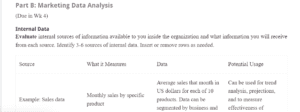Marketing Data Analysis
Internal Data
| Source | What it Measures | Data | Potential Usage |
| Sales data | · Shows the periodical demand for each product
· Shows the sales for each salesperson (in total or average) · Average orders by client, region, or customer type · Shows the most profitable products and clients |
· The average sales for each product sold at Amazon can be categorized according to region and client segment. | · Useful for analyzing product/service demand
· Making future projections · Identifying the most profitable products and services. |
| Financial data | · Shows the cost of goods sold
· Indicates the transportation/delivery costs · Highlights the cost of storage/warehousing · Shows administrative costs · Shows payroll costs · Shows marketing costs |
· The monthly financial data shows the cost of doing business and the margins generated. | · It can be used to show the company’s profitability
· Used to assess the marketing efforts through generated sales |
Secondary Data
| Source | What it Measures | Data | Potential Usage |
| Government statistics | · Shows export data related to private or public sector
|
· Percentage of exports/imports for major players | · Shows the company’s export and import data |
| Media sources | · Provide data on various industries’ economic performances
· Highlights the main aspects such as loss or profits |
· Monthly/annual profits/loss of major organizations
· Price per share |
· It can be used to determine the company’s profitability
|
Primary Data
| Source | What it Measures | Data
|
Potential Usage |
| Focus group | · Usage of product usage, satisfaction with product, process of decision-making process | Qualitative | · Provides information on market reactions from different segments
· Provides present gaps in the market · Identifies places of product or service improvement |
| Customer feedback | · Product satisfaction | Qualitative | · Identifies areas of improvement |
| Customer Inquiries | · Market gaps | Qualitative | · Identifies the clients’ desires
· Highlights opportunities in the market (Kestenbaum, 2020). |
Customer Relationship Management
| CRM Touchpoint | Purpose & CRM Objective | Data | Potential Data Usage |
| Customer profile information on the website | · Provides customer information
· Gives purchase history · Provides search history on the company’s website
|
· Geographic location- address
· Customer identity · Source of reference Email address Phone number |
· Identify new and returning customers
· Total purchases for each customer · Identify geographic data. · Ideal for targeted marketing · Identifies popular products in different market segments |
| Customer reviews | · Provides feedback on various products
· Highlights unmet client needs |
· Product purchased
· Quality of product · Comparison to the advertised items · Value for money · Delivery efficiency |
· It can be used to assess clients’ satisfaction with products
· Highlights areas of improvement · Guides other clients in the decision-making process (Dudovskiy, 2020). |
References
Dudovskiy, J. (2020). Amazon Segmentation, Targeting and Positioning: Widest Range of Target Customer Segment.
Kestenbaum, R. (2020, February). Amazon Could Be Vulnerable To Competition, And This Is How. Forbes.
Sadq, Z. M., Sabir, H. N., & Saeed, V. S. (2018). Analyzing the Amazon Success Strategies. Journal of Process Management –New Technologies, International, 6(4), 65-69.
ORDER A PLAGIARISM-FREE PAPER HERE
We’ll write everything from scratch
Question
Part B: Marketing Data Analysis
(Due in Wk 4)

Marketing Data Analysis
Internal Data
Evaluate internal sources of information available to you inside the organization and what information you will receive from each source. Identify 3-6 sources of internal data. Insert or remove rows as needed.
| Source | What it Measures | Data | Potential Usage |
| Example: Sales data | Monthly sales by specific product | Average sales that month in US dollars for each of 10 products. Data can be segmented by business and consumer markets. | Can be used for trend analysis, projections, and to measure effectiveness of promotions. |
Secondary Data
Evaluate secondary data sources and the specific information you need from each source. Insert or remove rows as needed.
| Source | What it Measures | Data | Potential Usage |
| Example: retail store analytics | Dollar value of sales by quarter by major product categories | Total sales of major players | Market Share Analysis
Seasonal patterns |
Primary Data
Evaluate primary data needs to create and evaluate the marketing plan. Insert or remove rows as needed.
| Source | What it Measures | Data
|
Potential Usage |
| Example: Focus group | Product usage, motives, identify group level satisfaction, decision process, etc. | Qualitative | Identify different reactions of market segments to product. Identify marketing opportunities, product/service flaws and opportunities |
Customer Relationship Management
Establish customer touchpoints and develop appropriate CRM events for customer acquisition, retention, and profitability. Insert or remove rows as needed.
| CRM Touchpoint | Purpose & CRM Objective | Data | Potential Data Usage |
| Example: Customer profile information on website | Starts the account for visitors: name, geography, email address (Customer acquisition)
|
Presale: geographic location; customer id, source of reference
Email address Post sales: address, product purchased, quantity, price. |
Track new and returning customer counts, total period purchases by customer ID, geographic sales data. Can be used for loyalty rewards, retention, and targeted marketing. |

